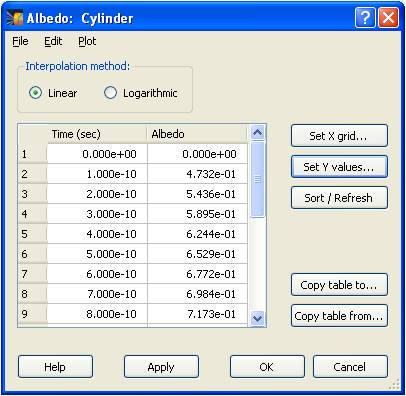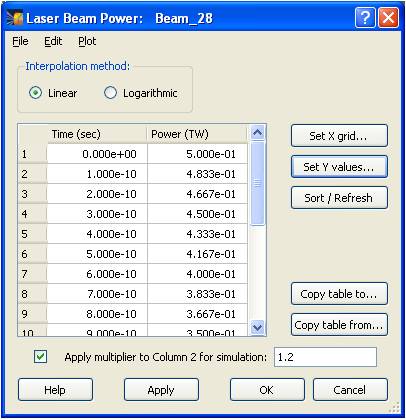

| CONTENTS | GLOSSARY | SUBJECT INDEX | SEARCH DOCUMENTATION |
Two-column data tables are used in specifying the time dependence of:
When computing properties at a given simulation time, VISRAD checks to see if the quantity is constant (time-independent) or variable (time-dependent). If time-dependent, relevant quantities are obtained by interpolation (either linear or logarithmic) of the two-column table data.
If the simulation time is outside of the bounds of the table, VISRAD uses the table value at either the minimum or maximum table time (whichever is closer).
Tables can be populated by any of the following approaches:
For some tables (e.g., the laser beam powers table), a multiplier can be applied to the table values (see below). In this case, the values displayed in the table do not change, but the multiplier is applied at the time calculations are performed.
To apply check the box located under the table and enter the value of the multiplier.

To import data from a multi-column ascii file, select File | Import Data. Table data can also be written to a file by selecting File | Export Data.
The Edit menu provides capability for:
- inserting and deleting rows
- copying, pasting, and clearing selected portions of the table
- clearing the entire table
The data in the table can also be plotted using Plot | Table data. An example plot is shown below.
A grid of "X" (e.g., time) values can be conveniently set up via the Set X Grid button. Using this, a grid of either linearly or logarithmically spaced values are added to the table.
"Y" values can be specified using analytic expressions (for Windows platforms only). The expression operates on x-values currently in the table. The analytic expression can be applied to the entire grid or a portion of it by specifying a range for the x-values.
| Copyright © 2000-2025 Prism Computational Sciences, Inc. | VISRAD 21.0.0 |